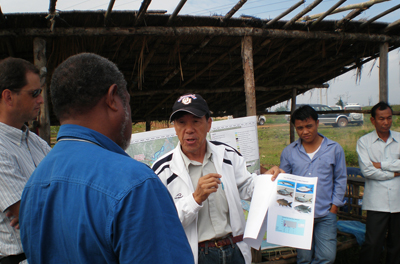Supporting Hydropower in Papua New Guinea

Key Contact
Wendy E. Hughes
Start Date
End Date
Funding Amount
$ 34,245
Knowledge-providing Countries
Knowledge-receiving Countries
Summary
The Government of Papua New Guinea (PNG) has prioritized tapping renewable energy sources, including hydropower, to increase the share of households with access to electricity from 13 percent to 70 percent by 2030. In 2010, PNG officials began to work with the World Bank to prepare the Energy Sector Development Project (ESDP) to strengthen the strategic framework and policies for renewable energy and rural electrification, and to attract hydropower investors for the Port Moresby electricity grid. The Bank first organized a workshop in PNG in September 2010 to investigate hydropower development options, inviting Laotian officials who had developed the regionally renowned Nam Theun 2 (NT2) hydropower plant. In response to a request from PNG, the Bank organized a visit to Laos so PNG officials could learn how the NT2 project was structured, and how to manage technical, social, and environmental challenges.
The week-long visit in October 2011 included officials from PNG’s Department of Treasury, Department of National Planning, Department of Petroleum and Energy (DPE), PNG Power Limited (PPL), Independent Public Business Corporation (IPBC), and a prominent NGO. Bank staff engaged in energy projects in these countries also attended. Delegates met with staff from the Laos Ministry of Energy and Mines, the Nam Theun 2 Power Company (NTPC), and the agency managing the NT2 watershed and resettlement of impacted communities. The visit culminated in a “wrap-up” session to capture lessons, which delegates shared with their organizations back home.
The visit increased delegates’ understanding of the technical, social, and environmental approaches to hydropower development and helped them reach consensus on energy policies and next steps. After the visit, PPL developed and endorsed a social and environmental framework for the proposed ESDP that engages stakeholders in a highly consultative process.
More broadly, the visit and other technical assistance (TA) – the workshop in PNG and a PPIAF-funded program on options for hydropower development – helped shape the ESDP’s design. Approved in 2013, the ESDP provides $8.2 million and TA for institutional and policy development in renewable energy and rural electrification, as well as the preparation of an 80 megawatt hydropower project for Port Moresby.
Beneficiaries / Participants
To promote economic growth, the Government of PNG (GoPNG) sought to increase the share of households with access to electricity from the current 13 percent to 70 percent by 2030. Hydropower is expected to play an important role in developing and expanding the country’s electric grid, since PNG has high rainfall and a mountainous terrain. Though hydropower currently provides less than 250 Megawatts (MW), studies suggest a potential of at least 10,000 MW through micro- and megaprojects. In 2010, the GoPNG began planning a Technical Assistance (TA) project, the Energy Sector Development Project (ESDP), to strengthen policy development and the strategic framework for renewable energy and rural electrification, and to attract investors for new hydropower generation to supply the Port Moresby electricity grid.
To help prepare the ESDP, the Bank organized a workshop in PNG on hydropower in September 2010, which included officials from Laos and Nepal and representatives from PNG’s Department of Treasury, Department of National Planning, DPE, PPL, private sector, non-governmental associations (NGOs), and other stakeholders. The workshop focused on different ways to structure a hydropower project, how to assess financing sources, and understanding environmental and social challenges. An official from Laos’ Ministry of Energy and Mines presented lessons from Laos’ Nam Theun II (NT2) hydropower project, including the success of multi-stakeholder consultations, the benefit-sharing approach followed in NT2, and different models of Public Private Partnerships (PPPs). PNG authorities expressed interest in visiting NT2 to deepen their learning. The Bank organized a study tour to Laos to enhance PNG officials’ skills in working with the private sector, communities, and stakeholders to develop hydropower in a sustainable, equitable manner. The tour centered on increasing officials’ understanding of the technical, social, and environmental approaches of the NT2 project and building consensus on the way forward with the ESDP.
Moving forward
The visit was part of a broader World Bank capacity building program. The initial workshop, the study tour to Laos, and the PPIAF-funded TA study of hydropower development options together informed the design of the ESDP. Approved in February 2013, the ESDP provides US$8.2 million in financing and TA to develop policies and strategies for renewable energy and rural electrification, as well as a new 80MW hydropower facility to supply the Port Moresby electrical grid.
This broader TA package also contributed to the development and approval of an Electricity Industry Policy (EIP) by the National Executive Cabinet at the end of 2011. The EIP provides a foundation for sustainable development in the power sector.

 China
China Colombia
Colombia Denmark
Denmark India
India Indonesia
Indonesia Mexico
Mexico Russian Federation
Russian Federation Spain
Spain United Kingdom
United Kingdom